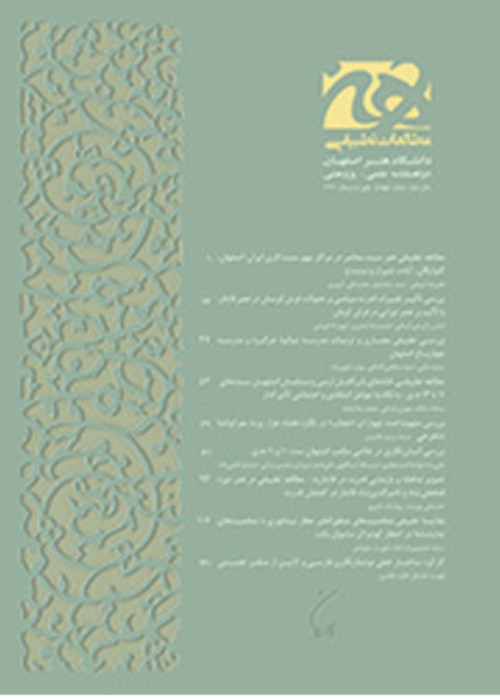Introduction to recognition of Iran's zoomorphic ceramic statues during 6th to 8th centuries after Hijrah
Author(s):
Article Type:
Research/Original Article (دارای رتبه معتبر)
Abstract:
This study aims to introduce and survey some of Irans zoomorphic ceramic statues during 6th to 8th centuries after Hijrah, coincident with SELJUQ, KHARAZMSHAHID and ILKHANID periods. The main object of the present study is to identify the most important formal and decorative features of Irans zooid sculptures during this period. Obviously, the study of different aspects of the aforementioned dimensions as well as the reasons for the boom in the construction of these statues during specific ages can enhance our qualitative and quantitative cognition toward these special artistic works in an Islamic art body. To this goal, 24 distinguished statues were selected from Iranian or foreign museums and were surveyed on the basis of above mentioned criteria. The major research questions in this project are: What are the reasons and domains of incidence of these forms in Irans Islamic middle centuries?
What are the most important functions and techniques used in the construction and decoration of these zooid ceramic statues in Irans Islamic middle centuries?
What are the similarities and differences of the aforementioned statues and those made in former periods and before the incidence of Islam in Iran?
The study was conducted in a descriptive -analytic methods and data were collected in a document library method. According to the findings of the study, zooid ceramic statues of this era are divided into two categories; category of independent or integrative application and a category with no specified application or merely decorative one. The most current decorative techniques were luster ware, enamel and monochrome glaze. Also, despite the extensive patterning from ceramic statues of pre-Islamic eras in aspects of decoration and especially figures forms, they have major differences with them. So that most figures are in arabesque, geometrical, zooid and human forms and in rare cases, they are inscription like. Of course in some cases, the above mentioned were Combined and side by side. But about the forms of these statues, besides the patterning of pre-Islamic instances, are perhaps influenced from new religious, political and cultural domains of this era such as the lifestyle of newcomer migrants or some SELJUQ kings names like Toqrol (in hawk statues) and Alp Arsalan (in lion statues) or some astronomical concepts.
What are the most important functions and techniques used in the construction and decoration of these zooid ceramic statues in Irans Islamic middle centuries?
What are the similarities and differences of the aforementioned statues and those made in former periods and before the incidence of Islam in Iran?
The study was conducted in a descriptive -analytic methods and data were collected in a document library method. According to the findings of the study, zooid ceramic statues of this era are divided into two categories; category of independent or integrative application and a category with no specified application or merely decorative one. The most current decorative techniques were luster ware, enamel and monochrome glaze. Also, despite the extensive patterning from ceramic statues of pre-Islamic eras in aspects of decoration and especially figures forms, they have major differences with them. So that most figures are in arabesque, geometrical, zooid and human forms and in rare cases, they are inscription like. Of course in some cases, the above mentioned were Combined and side by side. But about the forms of these statues, besides the patterning of pre-Islamic instances, are perhaps influenced from new religious, political and cultural domains of this era such as the lifestyle of newcomer migrants or some SELJUQ kings names like Toqrol (in hawk statues) and Alp Arsalan (in lion statues) or some astronomical concepts.
Language:
Persian
Published:
Journal of Motaleate-e Tatbighi-e Honar, Volume:7 Issue: 13, 2017
Page:
47
magiran.com/p1769615
دانلود و مطالعه متن این مقاله با یکی از روشهای زیر امکان پذیر است:
اشتراک شخصی
با عضویت و پرداخت آنلاین حق اشتراک یکساله به مبلغ 1,390,000ريال میتوانید 70 عنوان مطلب دانلود کنید!
اشتراک سازمانی
به کتابخانه دانشگاه یا محل کار خود پیشنهاد کنید تا اشتراک سازمانی این پایگاه را برای دسترسی نامحدود همه کاربران به متن مطالب تهیه نمایند!
توجه!
- حق عضویت دریافتی صرف حمایت از نشریات عضو و نگهداری، تکمیل و توسعه مگیران میشود.
- پرداخت حق اشتراک و دانلود مقالات اجازه بازنشر آن در سایر رسانههای چاپی و دیجیتال را به کاربر نمیدهد.
In order to view content subscription is required
Personal subscription
Subscribe magiran.com for 70 € euros via PayPal and download 70 articles during a year.
Organization subscription
Please contact us to subscribe your university or library for unlimited access!


